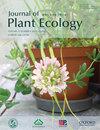Carbon-water coupling and its relationship with environmental and biological factors in a planted Caragana liouana shrub community in desert steppe, northwest China
IF 3.9
2区 环境科学与生态学
Q2 ECOLOGY
引用次数: 2
Abstract
The carbon and water cycle, an important biophysical process of terrestrial ecosystems, may be changed by anthropogenic revegetation in arid and semiarid areas. However, there is still a lack of understanding of the mechanism of carbon and water coupling in intrinsic ecosystems in the context of human activities. Based on the CO2 and H2O flux measurements of the desert steppe with the planted shrub Caragana liouana, this study explores the carbon and water flux coupling of the ecosystem by analyzing the variations in gross primary productivity (GPP), evapotranspiration (ET), and water use efficiency (WUE) and discussing the driving mechanism of biological factors. The seasonal variation in climate factors induced a periodic variation pattern of biophysical traits and carbon and water fluxes. The GPP and ET fluctuated in season, but the WUE was relatively stable in the growing season. The GPP, ET, and WUE were significantly driven by global radiation (Rg), temperature (Ta and Ts), water vapor pressure deficit (VPD), leaf area index (LAI), and plant water stress index (PWSI). However, Rg, temperature, and PWSI were the most important factors regulating WUE. Rg and temperature directly affected WUE with a positive effect but indirectly inhibited WUE by rising PWSI. Plant water stress inhibited photosynthesis and transpiration of the planted shrub community in desert steppe. When the plant water stress breaks a threshold (PWSI >0.54), the WUE will decrease since the GPP respond more quickly to the plant water stress than ET. Our findings suggest that policies related to large-scale carbon sequestration initiatives under afforestation must first fully consider the statuses of water consumption and WUE.西北荒漠草原人工柠条灌丛群落碳-水耦合及其与环境生物因子的关系
干旱半干旱区人为植被恢复可能改变陆地生态系统碳水循环这一重要的生物物理过程。然而,人类活动背景下固有生态系统中碳水耦合的机制仍缺乏认识。基于荒漠草原灌木柠条(Caragana liouana)的CO2和H2O通量测量,通过分析荒漠草原总初级生产力(GPP)、蒸散发(ET)和水分利用效率(WUE)的变化,探讨荒漠草原生态系统的碳水通量耦合,并探讨生物因子的驱动机制。气候因子的季节变化导致了生物物理特征和碳水通量的周期性变化模式。GPP和ET随季节波动,而WUE在生长季相对稳定。GPP、ET和WUE受全球辐射(Rg)、温度(Ta和Ts)、水汽压亏缺(VPD)、叶面积指数(LAI)和植物水分胁迫指数(PWSI)的显著驱动。然而,Rg、温度和PWSI是调节水分利用效率的最重要因素。Rg和温度直接影响WUE,但通过提高PWSI间接抑制WUE。植物水分胁迫抑制荒漠草原灌丛群落光合和蒸腾作用。当植物水分胁迫超过阈值(PWSI >0.54)时,由于GPP对植物水分胁迫的响应比ET更快,水分利用效率将下降。研究结果表明,造林下大规模固碳措施的相关政策必须首先充分考虑水分消耗和水分利用效率的状况。
本文章由计算机程序翻译,如有差异,请以英文原文为准。
求助全文
约1分钟内获得全文
求助全文
来源期刊

Journal of Plant Ecology
生物-植物科学
CiteScore
4.60
自引率
18.50%
发文量
134
审稿时长
3 months
期刊介绍:
Journal of Plant Ecology (JPE) serves as an important medium for ecologists to present research findings and discuss challenging issues in the broad field of plants and their interactions with biotic and abiotic environment. The JPE will cover all aspects of plant ecology, including plant ecophysiology, population ecology, community ecology, ecosystem ecology and landscape ecology as well as conservation ecology, evolutionary ecology, and theoretical ecology.
 求助内容:
求助内容: 应助结果提醒方式:
应助结果提醒方式:


